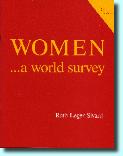Ruth Leger Sivard's |
||
 |
|
Home___Publications___Background___Contact |
|||
| |
||||||
Women...a World Survey by Ruth Sivard |
||
Summary by Ruth Sivard The changes achieved in women’s status during the period since World War II have been extremely uneven and, on the whole, modest. Whether in the economy, education, health, or government, there is no major field of activity and no country in which women have attained equality with men. The influx of women into the paid labor force has not significantly narrowed the gap between men’s and women’s pay; nor has it stemmed the rising tide of poverty among women. Despite the key role that women have in Third World economies, They have been largely by-passed in development strategies. |
||||
Throughout the world women are still disproportionately represented among the poor, the illiterate, the unemployed and the underemployed. They remain a very small minority at the centers of political power. Yet the “silent revolution” is slowly gaining in strength. Women are more educated, more active economically, more successful politically than they were a few decades ago. There is an undercurrent of confidence and cooperation among them that is new to the world, and has great promise. Perspectives Forty years ago the Charter of the United Nations reaffirmed the signers’ “faith in fundamental human rights... in the equal rights of men and women.” In 1948 The principles of the Charter were made more explicit in the Universal Declaration of Human Rights. In Many respects the years since World War II represent a period unique in history. Like human rights, national rights gained new attention. Ninety-three independent countries were born. Growth, as well as change, was in the air. The global economy expanded at an unprecedented rate. The rise in world population was larger than the total increase in the three centuries preceding. Dizzying advances were made in science and technology. For the 50 percent of the world population that is female, this relatively brief period- little more than the life span of one generation- opened up new vistas of promise and equity. In the decade beginning 1945 more nations extended suffrage to women than had granted it over all the years prior to World War II. New constitutions were written and old ones ammended to incorporate UN inspired principles of equality of rights and of opportunities for both sexes. Looked at now, 40 years after the Charter, The progress toward equality actually achieved by women is considerably more modest than the promise. The factual evidence available shows a continuing wide gap between the status and rights of women and men. There is no country in the world where this gap has been eliminated in all major fields of activity. It is clear that discrimination, embedded in attitudes, customs and laws over thousands of years, cannot be removed in a few decades. Yet ther are some bright spots in the record of these few decades, and it is the intention of this report to explore what they are, as well as what is left undone. Diversity Two and one-half billion women, speaking 2,976 languages and living in countries where the average annual income ranges from $200 to $30,000 per capita, represent a vast and far from homogeneous portion of humanity. All generalizations about their situation, roles and status in society must be seen as simplifications of a variety that is virtually infinite. Yet universal averages can convey a sense of the scope of this diversity. Life expectancy is a broad measure of national well-being. It shows that the average life span of women in some countries is almost double that in others. In fact, women in richer countries may hope to live 30 years or more longer than women in some of the poorer countries. Adult literacy rates (see map above) have an even wider gulf between the highest and the lowest national averages. From 99 to 100 percent in most developed countries, the proportion of adult women who are literate drops to a low of 3 percent in the least developed. (In both life span and literacy, the range from the highest national average to lowest is greater among women than among men.) Other evidence provides contrasts that are equally broad. There are countries where nine out of ten women over the age of 25 have no schooling whatsoever; at the other extreme, six out of ten women of university age are enrolled in higher education. In some countries, women begin their reproductive years before age 15 and as a rule bear seven or eight children in their lives; in others, the average is less than two children. In some, women take an active political role- and in a few have reached the pinnacle of political power- but in others they have not yet attained the minimal political right of suffrage. At subnational levels and in comparisons between urban and rural areas, these contrasts may become even stronger. A brief report of this nature, however, must confine itself largely to averages, and draw out of them what information they can yield about the nature of women’s public lives and the processes of change affecting them. Commonality Despite the diversity of experience and status, women have recently, and to a suprising degree, begun to come together on common ground. The gulf between the most and least priviledged among them may seem in many cases to be wider than the gulf between women and men in particular cultures, but what women have found to bind them together is a single thread that winds through all cultures. They share a sense of an inequality of opportunity, the injustice of traditionally-imposed second place, whether in the family, social, economic or political setting. Women’s sense of inequality shared has produced a movement for change which is now emerging everywhere. It differs from earlier drives by women for equality in several respects:
|
||||||
